Christoph Weiditz
Christoph Weiditz (1498, Strasbourg or Freiburg im Breisgau - 1559, Augsburg) was a German painter, medalist, sculptor and goldsmith. His artistic development goes from a naïve-German record of the Renaissance influences to a clever mannerism. Christoph Weiditz is one of the four most important German medalist of the Renaissance, alongside Hans Schwarz, Friedrich Hagenauer and Matthes Gebel.
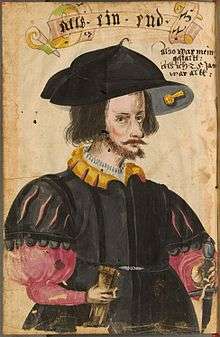
Selfportrait of Christoph Weiditz, January 1523
Life
He was the son of Hans Wydyz, Wyditz or Widitz (ca. 1460 - 1520), a sculptor who worked in Freiburg between 1497 and 1514. He was also the brother of Hans Weiditz, the Younger (1493–1537), a famous woodcut artist.
Between 1528 and 1529 he stayed in Spain and made drawings of the folk costumes the inhabitants of the Iberian Peninsula.[1][2][3]
Gallery
- Drawings of Christoph Weiditz from his Trachtenbuch, Nuremberg, Germanisches Nationalmuseum.
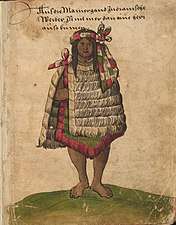 Auf die Manier gand Indianische Weiber, Ist nit mer dan aine herrauss kumen. p. 1
Auf die Manier gand Indianische Weiber, Ist nit mer dan aine herrauss kumen. p. 1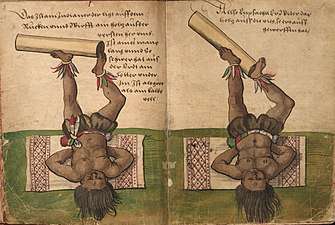 Das Ist ain Indianer der ligt auff dem Rucken, vnnd Wirfft ain holtz aus der versten heraus, Ist aines mans lang vnnd so schwer hat auf der Erdt ain lötter vnder Im Ist als gros als ain kalbs vell p. 8-9
Das Ist ain Indianer der ligt auff dem Rucken, vnnd Wirfft ain holtz aus der versten heraus, Ist aines mans lang vnnd so schwer hat auf der Erdt ain lötter vnder Im Ist als gros als ain kalbs vell p. 8-9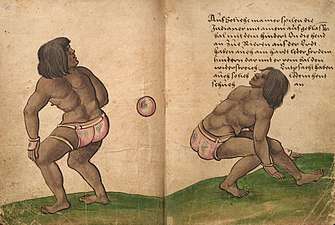 Indianer beim Ballspiel p. 10-11
Indianer beim Ballspiel p. 10-11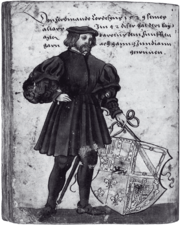
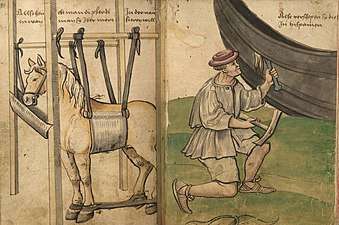 Wie die Pferde in die Schiffe verfrachtet werden p. 81-82
Wie die Pferde in die Schiffe verfrachtet werden p. 81-82
Bibliography
- Christoph Weiditz, Authentic Everyday Dress of the Renaissance. All 154 Plates from the „Trachtenbuch“. Nachdruck der Ausgabe Berlin 1927. Dover Publications, New York NY 1994, ISBN 0-486-27975-8.
- Theodor Hampe (dir.), Das Trachtenbuch des Weiditz von seinen Reisen nach Spanien (1529) und den Niederlanden (1531/32), 1927. Réimpression : , New York NY, Dover Publications, 1994 ISBN 0-486-27975-8 (Google Books, extraits). (in German)
- Andrea McKenzie Satterfield, The assimilation of the marvelous other: Reading Christoph Weiditz's Trachtenbuch (1529) as an ethnographic document (full text).
gollark: I think it does that when some packets go missing or something.
gollark: It's working fine, I'm on it.
gollark: What, in CC or for switchcraft?
gollark: T̙hͬi̭s̫ ̆įs̀ ͭa̲ ̕g͞r͙éa͜t͓ ̨d͏e͛m͖o͖nͦs̼t͙r͝a̤t̰i͖o̩n̗ ͅo̥f́ ̆tͮh͑ḙ ̆n̏e͑ȅd̔ ͓f̍o̔r͂ ̿U͆n̘i̛c̋o͍d̝ē ͏s̙u̥p͉pͨǫr̓t͓ ͢iͫnͯ ̀C̞Cͧ.̪~
gollark: ṳn̴ìc͇o̔ḋe̤ ͖i̺s̽ ̇s͑u͒c͡h̵ ͪfͬu͟n͘.̐~
References
- Writing New Worlds: The Cultural Dynamics of Curiosity in Early Modern Europe. Cambridge Scholars Publishing. 11 May 2016. p. 110. ISBN 9781443894302.
- Classen, Albrecht (2004). "Spain and Germany in the Late Middle Ages: Christoph Weiditz Paints Spain (1529) A German Artist Traveler Discovers the Spanish Peninsula". Neuphilologische Mitteilungen. Modern Language Society. 105 (4): 395-406. JSTOR 43343970.
- Satterfield, Andrea McKenzie (12 April 2007). Szépe, Helena K.; Benadusi, Giovanna; Fraser, Elisabeth (eds.). "The Assimilation Of The Marvelous Other: Reading Christoph Weiditz's Trachtenbuch (1529) as an Etnographic Document". College of Visual and Performing Arts. University of South Florida. Retrieved 19 October 2019.
External links
| Wikimedia Commons has media related to Christoph Weiditz. |
This article is issued from Wikipedia. The text is licensed under Creative Commons - Attribution - Sharealike. Additional terms may apply for the media files.